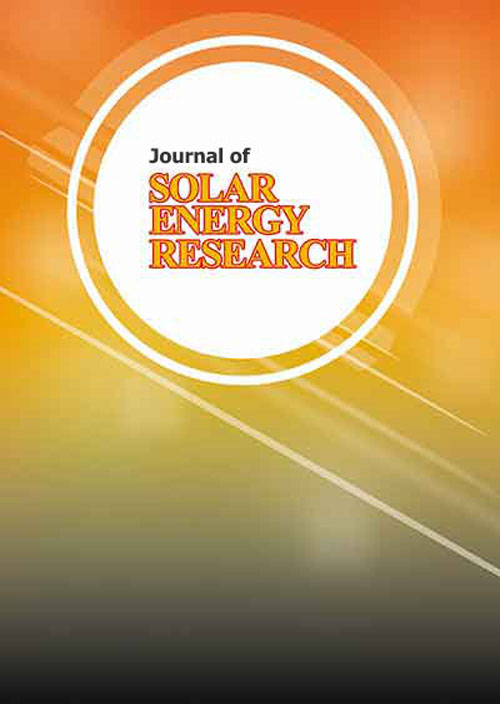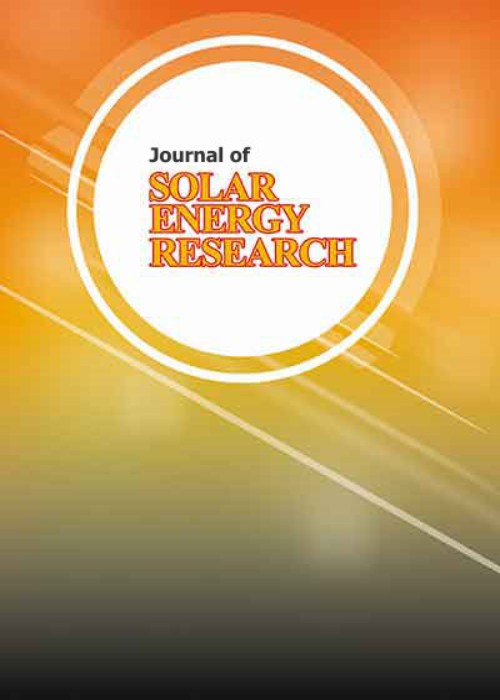فهرست مطالب

Journal of Solar Energy Research
Volume:6 Issue: 1, Winter 2021
- تاریخ انتشار: 1400/02/07
- تعداد عناوین: 6
-
-
Pages 625-633
In this paper, a combined PVT-heat exchanger cycle with the aim of cooling the PVT system and supplying the required air of an air-conditioning system in comfortable conditions is investigated. The effect of weather conditions (radiation intensity and ambient temperature) on the electrical efficiency of PVT system and reduction of carbon dioxide emissions has been investigated. For this purpose, several cities in Iran with different climates have been considered. The results show that the electrical efficiency of PVT system increases by5% in winter and 8% in summer. About 86% of the generated electricity is stored while the electrical energy required by the fan and pump and the cooling and heating energy of the building are supplied. The city of Tabriz has the highest electrical efficiency of about 0.1622. Carbon dioxide emissions were also calculated. The use of the proposed hybrid system can be effective in reducing the emission of pollutants.
Keywords: thermal analysis, Thermal performance, PVT-HEX, air condition system, emission -
Pages 634-647True and proper employment of daylight illumination is one of the principles of building design. Daylight has a dynamic nature which helps the designers to achieve suitable space quality. To employ the potentials of daylight, the proper model must be similar to light properties from the nature prospective. This study is aimed at investigation and explanation of an optimum dynamic lighting system to equip office building windows in order to deepen, balance and control the received light. For this purpose, physical variables including the floor height, the ratio of the occupied surface by window to the total surrounding surface (Window area or window-to-wall ratio (WWR)) and the dimensions of the reference office room were modelled in the Rhino software. The lighting of the reference room in Ahvaz climate was simulated by Grasshopper, Ladybug, Honeybee and Honeybee-plus plugins in the Rhino software, and the lightness parameters were analyzed based on the LEEDV4 standard. According to the results and software outputs, design strategies were proposed to overcome lighting defects by a dynamic lighting system, and their performance and effectiveness on improvement of office space lighting were investigated by the software. It was found that an optical niche with optimized dimensions and angle, and its installation on a window with optimum proportions in the office room studied leads to deeper light penetration into the room. The employment of movable window canopy with retractable plates containing sun location-sensitive sensors during whole daytime and critical days was found to control the glare phenomenon caused by the entrance of natural light and contributed to a space in the visual ease region.Keywords: dynamic lighting system, Light shelf, Daylight, Optimization, side lightning parameters
-
Pages 648-655It is very useful to use the solar irradiation for photocatalytic property, but need to reduce the band gap by doping the ions. In this paper ZnS (zinc sulphide) nanoparticles has been synthesized via co-precipitation and hydrothermal method. The co-precipitation and hydrothermal are simple, economical methods and they were used for a green surfactant assisted method for fabrication of ZnS and ZnS– (Ni and Li) doped nanoparticles. Glucose, sucrose or fructose were applied separately as green surfactants and capping agents. The Ni and Li ions were doped in ZnS nanocrystals for improvement of band gaps. The crystalline structure of zinc sulphide nanoparticles was investigated by X-ray diffraction (XRD) spectra and crystallite size of particles were calculated by debye-scherrer equation. The shape and morphology of ZnS particles was studied via scanning electron microscope (SEM). The Fourier-transform infrared spectroscopy (FTIR) was applied for the absorption peak of Zn-S bonding atoms. The photoluminescence (PL) measurement of the ZnS nanopowder was investigated at room temperature with an excitation wavelength around 360 nm. The photo-catalyst properties of ZnS nanoparticles were studied via ultraviolet – visible spectra (UV – Vis) of four different azo dyes acids under solar irradiation in times less than 120 min.Keywords: Semiconductor, Azo dyes, Photoluminescence, UV irradiation, Green surfactant
-
Pages 656-663Long-term wind speed changes have a direct impact on optimal planning and economic parameters of the HRES. This study was conducted to determine the effects of long-term wind speed variations on optimal equipment layout and planning of a Hybrid Renewable Energy System (HRES). For this purpose, integrated and comprehensive studies and collected data on wind speed changes, from 40 meteorology stations from 1975 to 2005 across Iran in four different seasons are used. To evaluate the wind potential of different regions and assess the effects of wind speed changes on wind turbine production, average seasonal wind speed changes in each decade is considered in the optimal planning of a specific HRES for eight selected cities in different regions of Iran. Homer software is used to calculate the effects of wind speed changes on the annual production of wind turbines, cost of energy (COE ($/kW)), total Net Present Cost (NPC ($)), operating cost (OC ($/yr)), and diesel generator fuel consumption (Liter/yr). For most cities that have a major change in the long-term wind speed, the optimal number of equipment, rating power of HRES equipment, and annual production of wind turbines changed. Therefore, the COE, total NPC, and diesel generator fuel consumption change more than the initial estimation considering the stable climate condition. The study results showed that, due to changes in the annual wind speed, the annual production of wind turbines for different regions changes between -28% and +10%. For this wide range in the power production of wind turbines, the COE changes between 0.203 ($/kWh) and 0.34 ($/kWh).Keywords: HOMER, Optimal Planning, Hybrid Renewable Energy System (HRES), Wind Energy, Wind Speed Changes
-
Pages 664-677In addition to simultaneously supplying heat and electricity, CCHP systems also provide the cooling demand of the buildings. The input energy of this system can be supplied from renewable energy sources such as solar energy, geothermal energy and so on. Compared to conventional power generation systems, cogeneration systems have higher energy efficiency, lower pollutant production, and higher reliability. In this paper, a solar-powered CCHP system equipped with a PEM electrolyzer and fuel cell is simulated and optimized. The combination of the PEM electrolyzer and the fuel cell is used in order to provide sustainable heat and electricity. For this purpose, the electrical power produced in the cycle is converted to hydrogen by the electrolyzer as the demand for electricity is low and converted to electricity by the fuel cell when needed. The results of system optimization showed that energy efficiency and exergy efficiency increased by 22.32% and 8.61% in the first scenario, respectively. Moreover, the total cost rate of the system is reduced by 6.65% in the second scenario.Keywords: Solar energy, cogeneration, CCHP, electrolyzer, Fuel Cell, Optimization
-
Pages 678-687Photovoltaic (PV) systems have been gaining great attention during the last decade. One of the main faults in PV arrays is partial shading, affecting its electrical parameters. Failure to detect this fault may result in optimal generated power reduction and hot spotting leading to damage to cell encapsulant and second breakdown. This paper develops a partial shading detection algorithm that only requires the available measurements of array voltage and current. By quantifying the wave-shape of the super-imposed component of PV array power by the skewness function, it can discriminate a partial shading condition from the short-circuit and high-resistance faults. The developed scheme is implemented in a central intelligent electronic device and does not require a communication link and training data set. The merits of the proposed partial shading detection algorithm are demonstrated through several fault scenarios using a 5×5 grid-connected PV generation system.Keywords: Fault Detection, Photovoltaic, partial shading, Skewness


